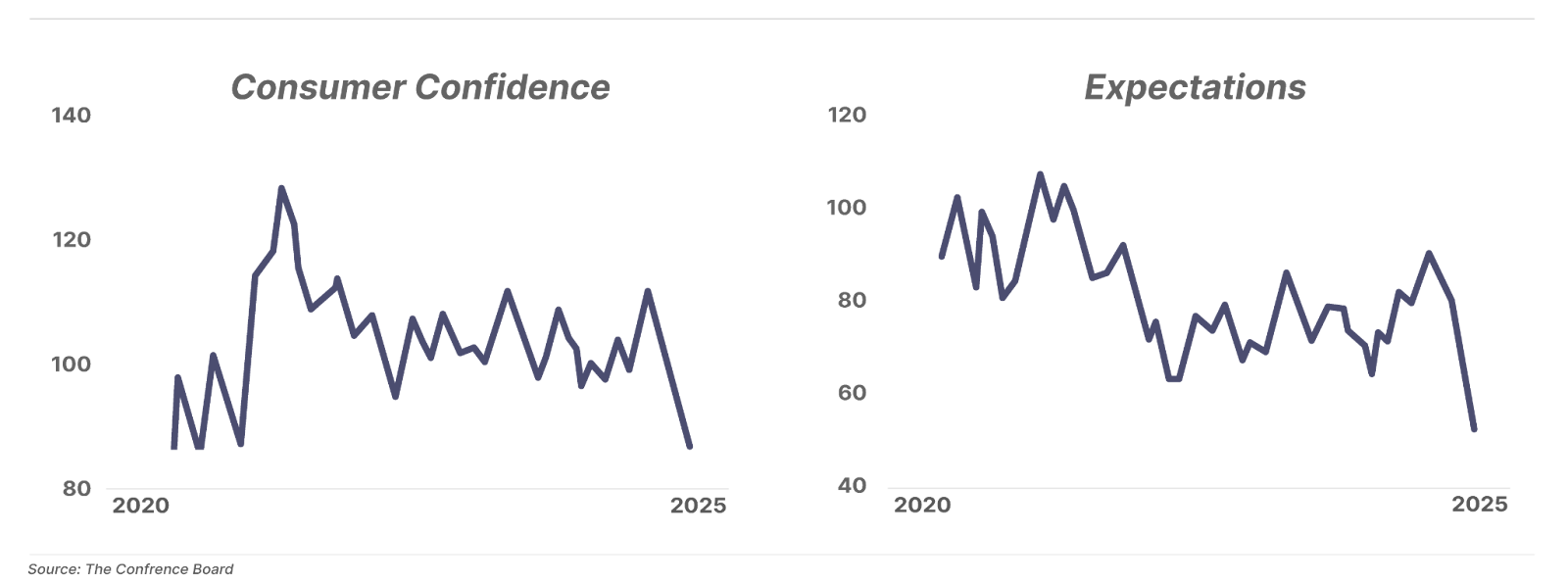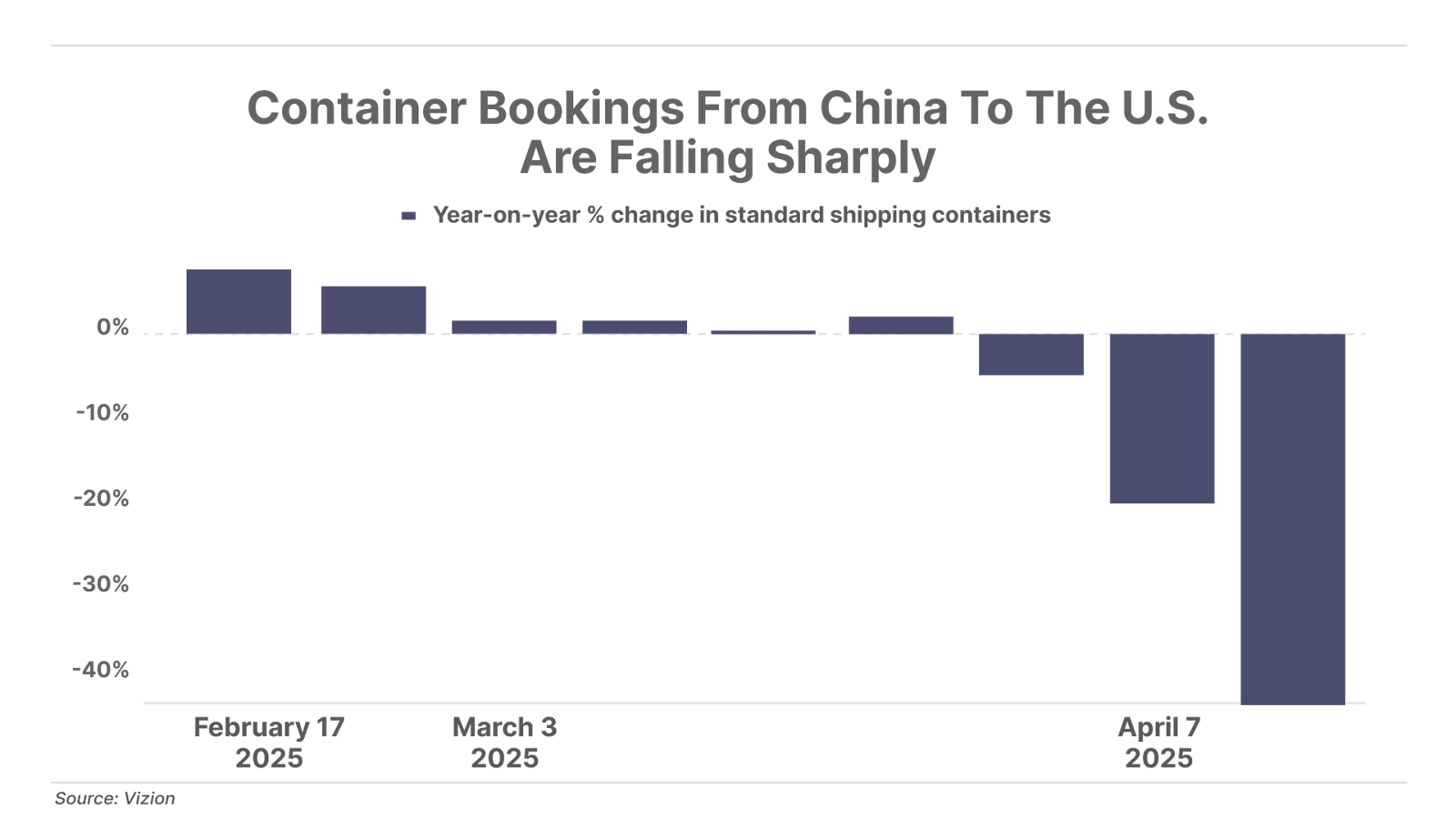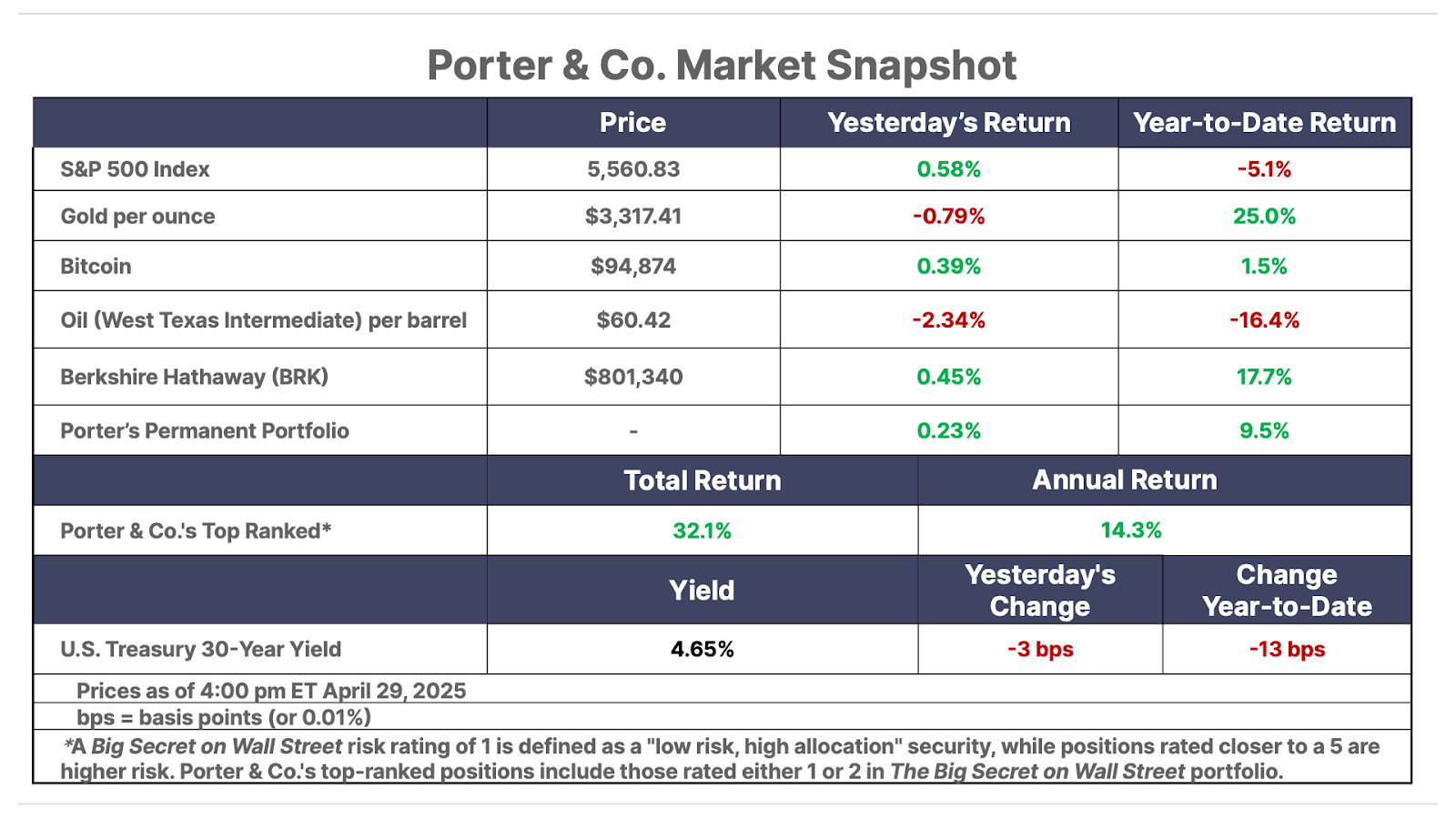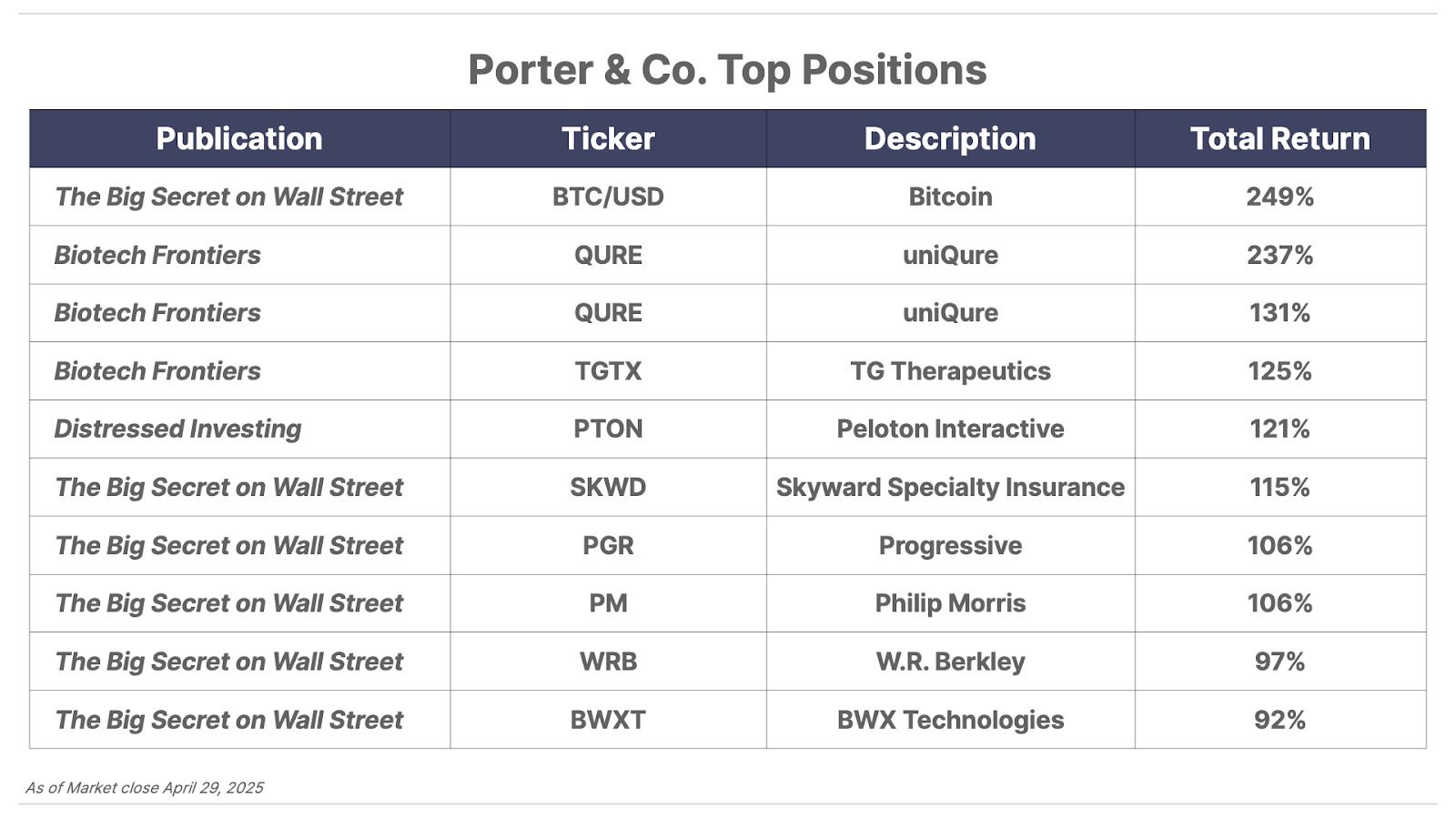Issue #49, Volume #2


Tough Times In The Market Create Outstanding Trading Opportunities
This is Porter’s Daily Journal, a free e-letter from Porter & Co. that provides unfiltered insights on markets, the economy, and life to help readers become better investors. It includes weekday editions and two weekend editions… and is free to all subscribers.
| Using the options market to establish a major portfolio position… Hershey is one of the world’s most valuable brands… Owning government bonds is not safer than owning stocks… Puts are insurance contracts… Most people who learn about this easy way to make money will screw it up… Global shipping has collapsed… |
Today I’m going to do something I very rarely do: detail one of my own trades from my personal account.
I don’t do this regularly because my personal finances – like yours – are often driven by idiosyncratic factors and because I frequently invest in private businesses that are closed to the public.
My sincere concern is that, if not executed carefully, the things like I describe below can lead to major losses.
I’m sharing this with you today because I suspect we have entered a very different world than the one we saw over the last decade in our financial markets. Since the Global Financial Crisis in 2008-09, central banks have used unprecedented monetary power to dampen volatility and control risk. As you know, every “crisis” was met with more money printing and government bond issuance. Interest rates were manipulated to zero… and then to below zero! Many of the world’s most important financial markets became woefully overvalued. And the reckonings have only just begun.
It will take a decade, or longer, for things like the multi-family housing market to sort out the incredible losses that investors now face. Investors in sovereign bonds have even larger problems.
These enormous embedded financial losses are creating a much riskier world, where I’m certain equity valuations will become compressed. In just the last two months, we’ve seen more volatility – with the CBOE Volatility Index (VIX) registering above 30 for weeks at a time – than I’ve seen in my entire career, outside of the Global Financial Crisis.
In this new era of volatility, we will see fantastic opportunities emerge in: distressed debt, biotech, and the options market, where volatility is priced every day.
To explain what these opportunities look like and how to trade them, I’m going to describe how I use the options market to establish major positions in my portfolio, while, at the same time, generating safe cash returns that are vastly more than you can earn in fixed income.
Some context is important.
First, I have studied The Hershey Company (NYSE: HSY) for almost 20 years. I’m convinced it is one of the world’s most valuable brands, and, because of its ownership (control is held by the Hershey Trust Company), I believe it is virtually certain to remain an independent public company. I regard an investment in Hershey – at a reasonable price – as being substantially less risky than holding cash or long-duration fixed income. In these ways, Hershey isn’t a typical stock. It is more like a national icon that pays a dividend.
Second, I fully intend to own a major position (10,000 shares or more) forever. Stocks like Hershey are a big part of my asset-protection and estate plan. This is something that’s hard for most people, who (foolishly) consider “stocks” a monolithic asset class – as being all the same and inherently risky. These investors subscribe to the view that owning government bonds is safer than owning stocks. I completely disagree: my view is that owning the bonds of a bankrupt, failing state with an addiction to warfare and a printing press is a recipe for financial disaster. I would much rather trust my family’s financial future to Hershey than to Congress.
Third, I have been waiting to establish a major position in the stock. Financial travails over the last decade – divorce and a massive tax bill related to the failed IPO of MarketWise – forced the liquidation of virtually all of my liquid assets.
And so, I’ve been waiting patiently for a chance to rebuild my position in Hershey.
Finally, on February 4, 2025, the price of Hershey closed at $144 per share. Shares had fallen, in nearly a straight line, from $200 earlier in the year. And they were far off the company’s all-time high of $275, from roughly a year earlier. The shares were trading at around 15x earnings, a level I consider to be a “good” price.
But… would shares keep falling?
Over the next two weeks, the shares rallied sharply and by February 20 were trading at $166. I decided to buy. If I had simply placed an order for 10,000 shares, I would have paid something like $1.66 million for my position. But, instead, I decided to sell “puts” – to use the options market to establish my position.
Puts are insurance contracts. When you sell puts you’re acting like an insurance company. For a premium ($10.50 per share), I agreed to buy 100 shares of Hershey at a fixed price ($170 per share), for a fixed duration (through Friday, May 16). In this way, I provided the buyer of the option insurance protection from Hershey falling below $170 through mid-May.
As you surely know, I consider insurance to be the greatest business in the world. And, from my perspective, selling puts on great businesses that you seek to own is a risk-free way of making money.
In this case, I was perfectly willing to buy the stock at $166. And by selling puts with a “strike” price of $170 (where the contract would be settled), I was collecting a premium of $10.50, meaning that my actual net cost to buy the stock would be lower than the current market price. Plus, these options gave me a fixed price. I don’t have to worry about bid/ask spreads when I’m buying my 10,000 shares. I get a fixed price.
I sold 100 contracts. Each contract represents 100 shares, ergo, I sold insurance on Hershey at $170 for $105,000 in premium.
This transaction has two outcomes, both of which I consider favorable.
1. If Hershey is trading for less than $170 through May 16, the owner of the insurance can “put” the shares to me at $170 each. Subtracting the premium I have already received, I will buy 10,000 shares of Hershey for around $1.6 million. This will make the company one of my major positions.
2. Or if the shares are trading for more than $170 on May 16 then these contracts will expire “out of the money,” and I will pocket the $105,000 in premium that I was paid on February 20.
There are dozens of variations on this basic strategy. For example, shortly after I sold these contracts, the price of Hershey increased rapidly, hitting $186 by March 10. The price of the puts I’d sold fell to less than $5. I could have bought them back at lower prices from where I sold, pocketing the profit (approximately $50,000), and then sold new puts with a later expiration date. This is called “rolling” your puts. I could have also bought “calls” (which are usually less expensive than puts) to finance an even more aggressive long position. Or I could have bought puts below my strike price to guard against unexpected volatility.
But I didn’t do any of those things because my strategy here is very simple: I want to be a permanent owner of Hershey. I know, sooner or later, investors will dump shares for some reason that’s meaningless in the context of a multi-decade investment, and I will be put these shares, at a price I chose. In the meantime, though, I should be able to generate close to $500,000 in annual income, which is a whole lot more than I can get in safe, short-duration fixed income. (If I put $1.6 million into short-term Treasuries, I might get 4% – just over $60,000 per year in coupons. I’ll get 6.5x more using puts.)
Plus, your broker will normally allow you to use your existing cash and securities as collateral for your put contracts, meaning you can use your existing securities to add this extra income without putting up additional cash. This can be a great way to substantially increase your portfolio’s return and to generate income.
But… just as sure as the sun rises… most people who learn about this very safe and very easy way to make a lot of money will find a way to screw it up.
After making a few successful put sales when the contracts expire worthless they pocket what seems like free money. Feeling smart, they start “premium shopping,” which means rather than selecting safe securities to sell puts against, they look for stocks that offer a lot of premium to put sellers.
The premium I received on my Hershey shares ($10.50) was only 6.2% of the strike price. I thought that was more than fair. It implies a 27% annual return, which is probably more than I will earn owning the stock directly. Premiums are based, largely, on volatility. And Hershey is a very low-volatility stock, so the premiums are relatively low.
But rather than simply taking the premiums that are available every day on great businesses at good prices, people inevitably seek larger premiums on riskier businesses. Soon they’re “premium shopping.” You can guess what happens next: they sell far too many contracts on a risky stock that falls 50% and they take a massive loss.
Or they will simply lose all discipline on position sizing. Let me give you some sense of proportion for position sizing. If I am put the shares in the contracts that I sold, Hershey will make up about 10% of my personal brokerage account and maybe 2% of my total liquid net worth. That’s a substantial asset, but I’m not betting the farm.
I’d encourage you to speak to your broker about getting set up with portfolio leverage and clearance for Level 4 options trading, which will allow you to sell puts while using your entire portfolio as your collateral. Every broker is different – most will ask you to confirm you have experience trading options and ask you to sign various forms to establish your ability to manage risk inherent in these instruments. After you get clearance to trade, I highly recommend starting small. Just trade one contract on a stock you love and are happy to own. Doing it yourself, you’ll see exactly how everything works. And as you get more experience and grow more comfortable, then you can make selling puts your normal way of building a position.
Find three to four great businesses that you’re genuinely hoping to build your portfolio around. Focus on businesses with legendary brands – icons in their fields. In our portfolio these names include stocks like Deere & Co. (DE), Uber Technologies (UBER), Loews (L), Philip Morris International (PM), The Hershey Company (HSY), Nike (NKE), Domino’s Pizza (DPZ), and PayPal (PYPL). You can also include legendary companies with incredible moats and business models, like Franco-Nevada (FNV), Viper Energy (VNOM), Winmark (WINA), and Danaher (DHR).
Get to know these businesses and know the price you’re always willing to pay to own these shares. We’ll help of course, but read the quarterly reports yourself. Keep updating your estimate of intrinsic value. And, if you can, buy a few shares and attend the annual meetings.
Then, instead of buying the stock directly when it’s trading at a good price, start a put-selling campaign based on the number of shares you can afford to buy. If that’s 1,000 shares, then you’re selling 10 put contracts.
Pick a strike price that, accounting for the premium you’re getting paid, is below the market price. Keep rolling the option (selling a new set of contracts) as long as you don’t get put the shares. Maybe you’ll end up collecting one premium, or maybe you’ll end up collecting 10 premiums. Either way, you’re only risking what you wanted to do anyways, which was buy the stock.
In the coming weeks, we’ll be starting a service for people who want to learn more about how to trade like this: the Porter & Co. Trading Club.
We’re definitely focused on safe strategies. And our work will be designed 100% to provide you with hands-on education that you can use immediately. I hope you’ll join us if you want to learn safe strategies to optimize your investing and to increase the income you can achieve from your portfolio.
History Says Gold Wins When This Signal Flashes – And It’s Flashing Now
Every time the Buffett Indicator has hit extreme levels, stocks have crashed – and gold has dominated the decade that followed. Today, the Buffett Indicator is at its highest reading in history… and Buffett himself is sitting on an unprecedented $325 billion cash pile. Sources say he’s preparing to deploy it – not into stocks, but into gold. Garrett Goggin has uncovered which gold company could be his next big move.
Three Things To Know Before We Go…
1. U.S. growth evaporates. This morning, the U.S. Commerce Department reported the economy contracted for the first time since early 2022. First-quarter gross domestic product (“GDP”) fell at an annualized rate of 0.3% – well below Wall Street economists’ expectations of a 0.4% increase, and down sharply from a 2.4% growth rate in Q4 2024. The decline was largely driven by a sharp rise in imports as companies attempted to front-run President Donald Trump’s tariffs.
2. Consumer sentiment nosedives. The latest data from the Conference Board showed U.S. consumer confidence fell to a five-year low in April. And their outlook for the future is even more bleak, with consumer expectations for the next six months dropping to the lowest level since 2011. Such downbeat levels of consumer sentiment rarely occur outside of recessions.

3. Global trade grinds to a halt. In the week following President Trump’s tariff announcement on April 2, global imports to the U.S. plummeted 64%. In April, bookings for standard shipping containers from China to the U.S. were down 45% year-over-year, and goods entering the U.S. from China in May are projected to be one-third lower than the same period last year. Absent a reversal in U.S. trade policy, a global recession now appears likely as global trade collapses.

And One More Thing… The Most Important Black Label Podcast Episode
On this month’s Black Label Podcast – an episode that Porter calls the most important ever recorded – Porter and co-host Aaron Brabham talk with Biotech Frontiers editor Erez Kalir… about a stock they think will rise 100x, about how what Erez discovered in a Kinko’s copy shop led to meeting Porter, and about the curious paradox that Trump’s tariff policy is unfolding under the watchful eye of hedge-fund great Scott Bessent, the Treasury Secretary. But they all agree with Porter’s comment: “It’s the most dangerous time in the investing world.”… Watch it here, right now.
Poll Results – Options Trading
On Monday, Big Secret On Wall Street analyst Ross Hendricks walked readers through a real-time trade using a strategy known as selling puts. At the end of Monday’s Journal, we asked readers: “Would you ever consider trading options?”
An overwhelming 97% of survey takers selected “yes.”
Look for more trading examples in the Daily Journal in the coming weeks.
And as always tell me what you think: [email protected]
Mailbag
It’s been a while since I sold puts – as you wrote about in Monday’s Daily Journal. I’ve had mixed results in the past. I did very well for a while… then gave it all back when I got a little too cavalier. I was following some guys with a put-selling model annualizing 50%, selling weekly puts on extremely volatile stonks – like Riot Platforms (RIOT), Strategy (MSTR), and Bitcoin (BTS) and tech-hype stocks. That works out OK until the stonks plummet. Whoops. At least I was wise enough not to follow the lemmings off the cliff… thanks Porter & Co.
So Monday’s Daily Journal was a welcome reminder that there is money to be made selling puts if I am intelligent about it. Only sell puts on money-making companies I am happy to own – like Viper Energy (VNOM) at attractive prices. Only sell when the odds and payoff are dramatically in my favor (elevated VIX).
On Tuesday, I sold VNOM $40 June 20 puts for $2.10 that annualizes out to 36.7%. Not bad, eh? (I know this goes against the recommendation for August puts, but I sleep a little better with the shorter time frame.)
I am a horse meeting water.
Matt V.”
Following the suggestion from Monday’s Daily Journal, I placed the order for an August 15, 2025, Viper Energy (VNOM) $40 sell put per the directions. I was taken aback by the max gain/loss of $570/$7200 and feel like that is a big risk. I’m new to selling puts so I may not be reading this correctly. The income is nice but I’m much more interested in VNOM at $40 per share. Thank you for the great content in Porter & Co.
Michael H.”
Porter’s comment: The total loss indicated there of $7,200 reflects the full risk if the stock goes to zero (net of the premiums received). It’s roughly the same amount of risk you take when buying an equivalent amount of shares (technically less risk, because of the put premiums received). We view the likelihood of the stock going to zero as very low, but the total risk calculation is technically accurate.
Good investing,
Porter Stansberry
Stevenson, Maryland


Please note: The investments in our “Porter & Co. Top Positions” should not be considered current recommendations. These positions are the best performers across our publications – and the securities listed may (or may not) be above the current buy-up-to price. To learn more, visit the current portfolio page of the relevant service, here. To gain access or to learn more about our current portfolios, call Lance James, our Director of Customer Care, at 888-610-8895 or internationally at +1 443-815-4447.
